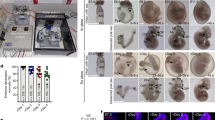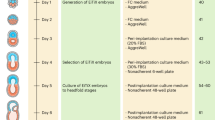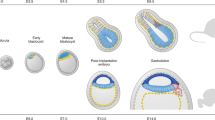Abstract
MICROSURGICAL techniques have proved valuable for investigations of the regulatory capacity of early mammalian embryos, including the developmental potential of single blastomeres from two-, four- and eight-celled embryos (see ref. 1 for review). However, the usefulness of radical microsurgery in experiments on early cleavage stages has been restricted largely to species in which such young embryos may be cultured in vitro, notably the mouse, as, in most instances, embryos less advanced than the late morula stage fail to survive in vivo if the zona pellucida has been removed or substantially damaged2–6. There has been no satisfactory method for culture in vitro of early cleavage stages in the sheep, and consequently there have been few reports of attempts to micromanipulate early sheep embryos7–9. I describe here a method whereby micromanipulated eggs can be protected during their early development in vivo and its use in an investigation of the developmental potential of single blastomeres from two-celled sheep embryos with the aim of producing monozygotic twins. The method involves coating the eggs with agar after microsurgery so as to seal defects produced in the zona pellucida.
This is a preview of subscription content, access via your institution
Access options
Subscribe to this journal
Receive 51 print issues and online access
$199.00 per year
only $3.90 per issue
Buy this article
- Purchase on Springer Link
- Instant access to full article PDF
Prices may be subject to local taxes which are calculated during checkout
Similar content being viewed by others
References
Wilson, J. B. & Stern, M. S. in The Early Development of Mammals (eds Balls, M. & Wild, A. E.) 81–95 (Cambridge University Press, 1975).
Tarkowski, A. & Wroblewska, J. J. Embryol. exp. Morph. 18, 155–180 (1967).
Modlinski, J. A. J. Embryol. exp. Morph. 23, 539–547 (1970).
Bronson, R. A. & McLaren, A. J. Reprod. Fert. 22, 129–137 (1970).
Moore, N. W., Adams, C. E. & Rowson, L. E. A. J. Reprod. Fert. 17, 527–531 (1968).
Trounson, A. O. & Moore, N. W. J. Reprod. Fert. 41, 97–105 (1974).
Pighills, E., Hancock, J. L. & Hall, J. G. J. Reprod. Fert. 17, 543–547 (1968).
Tucker, E. M., Moor, R. M. & Rowson, L. E. A. Immunology 26, 613–621 (1974).
Trounson, A. O. & Moore, N. W. Aust. J. biol. Sci. 27, 505–510 (1974).
Lawson, R. A. S., Adams, C. E. & Rowson, L. E. A. J. Reprod. Fert. 29, 105–116 (1972).
Whittingham, D. G. Nature 220, 592–593 (1968).
Rowson, L. E. A. & Moor, R. M. J. Reprod. Fert. 11, 207–212 (1966).
Moor, R. M. & Trounson, A. O. J. Reprod. Fert. 49, 101–109 (1977).
Nicholas, J. S. & Hall, B. V. J. exp. Zool. 90, 441–59 (1942).
Seidel, F. Naturwissenschaften 39, 355–356 (1952).
Tarkowski, A. Nature 184, 1286–1287 (1959).
Mullen, R. J., Whitten, W. K. & Carter, S. C. Annual Report of the Jackson Laboratory, 67–68 (Bar Harbor, Maine, 1970).
Mintz, B. in Methods in Mammalian Embryology (ed. Daniel, W. H.) 186–214 (Freeman, San Francisco, 1971).
Author information
Authors and Affiliations
Rights and permissions
About this article
Cite this article
WILLADSEN, S. A method for culture of micromanipulated sheep embryos and its use to produce monozygotic twins. Nature 277, 298–300 (1979). https://doi.org/10.1038/277298a0
Received:
Accepted:
Issue Date:
DOI: https://doi.org/10.1038/277298a0
This article is cited by
-
Asymmetric Contribution of Blastomere Lineages of First Division of the Zygote to Entire Human Body Using Post-Zygotic Variants
Tissue Engineering and Regenerative Medicine (2022)
-
Shaping up with morphogen gradients
Nature Cell Biology (2018)
-
Monozygotic twinning in the IVF era: is it time to change existing concepts?
Journal of Assisted Reproduction and Genetics (2018)
-
Agarose capsules as new tools for protecting denuded mouse oocytes/embryos during handling and freezing-thawing and supporting embryonic development in vivo
Scientific Reports (2017)
-
Totipotency segregates between the sister blastomeres of two-cell stage mouse embryos
Scientific Reports (2017)
Comments
By submitting a comment you agree to abide by our Terms and Community Guidelines. If you find something abusive or that does not comply with our terms or guidelines please flag it as inappropriate.



